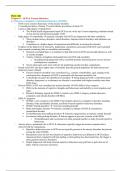Class notes
Chapter 6 - Obsessive Compulsive Disorder
- Course
- PSYC 300A
- Institution
- University Of British Columbia (UBC )
Welcome to the lecture notes on Obsessive-Compulsive Disorder (OCD). In this comprehensive collection, I explored the intricate aspects of OCD, an anxiety-related disorder. I delved into the diagnostic criteria, symptoms, and subtypes of OCD, providing an in-depth understanding of its clinical pres...
[Show more]



